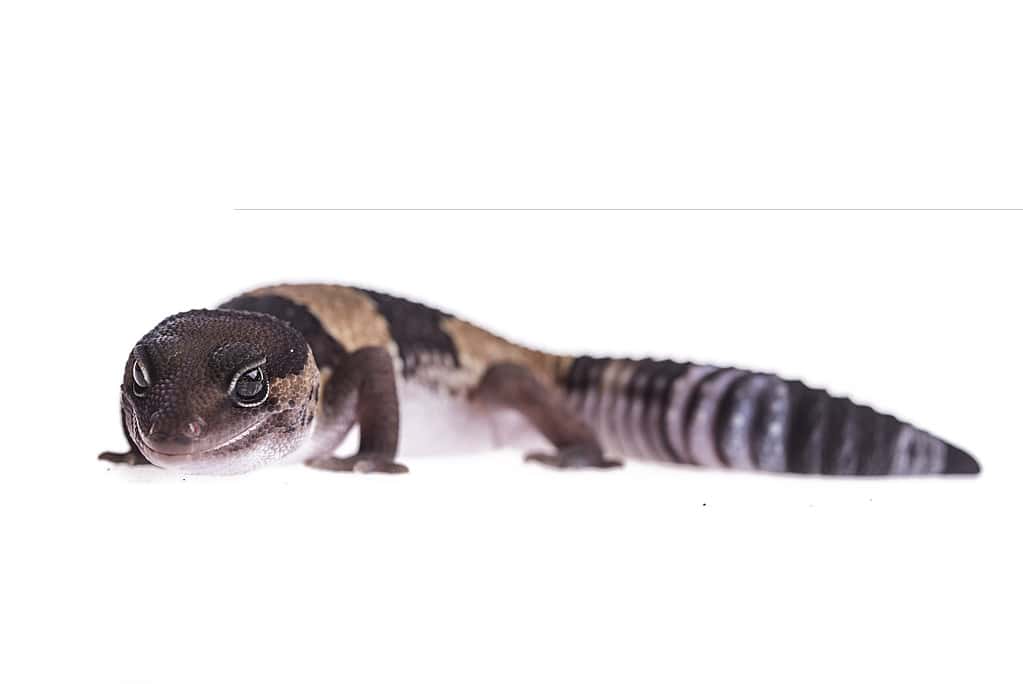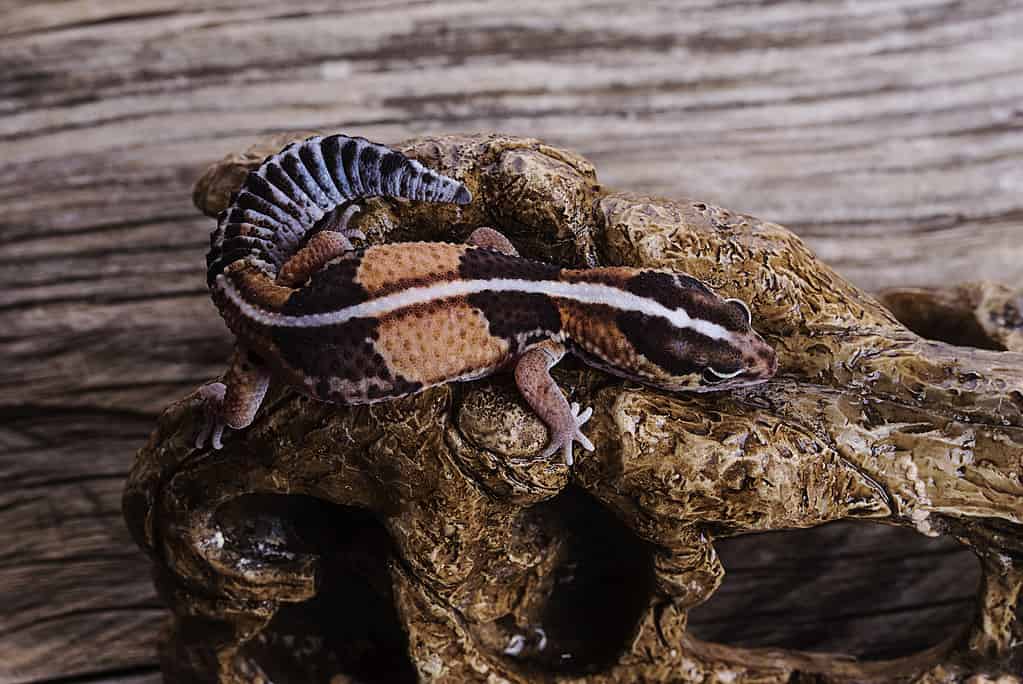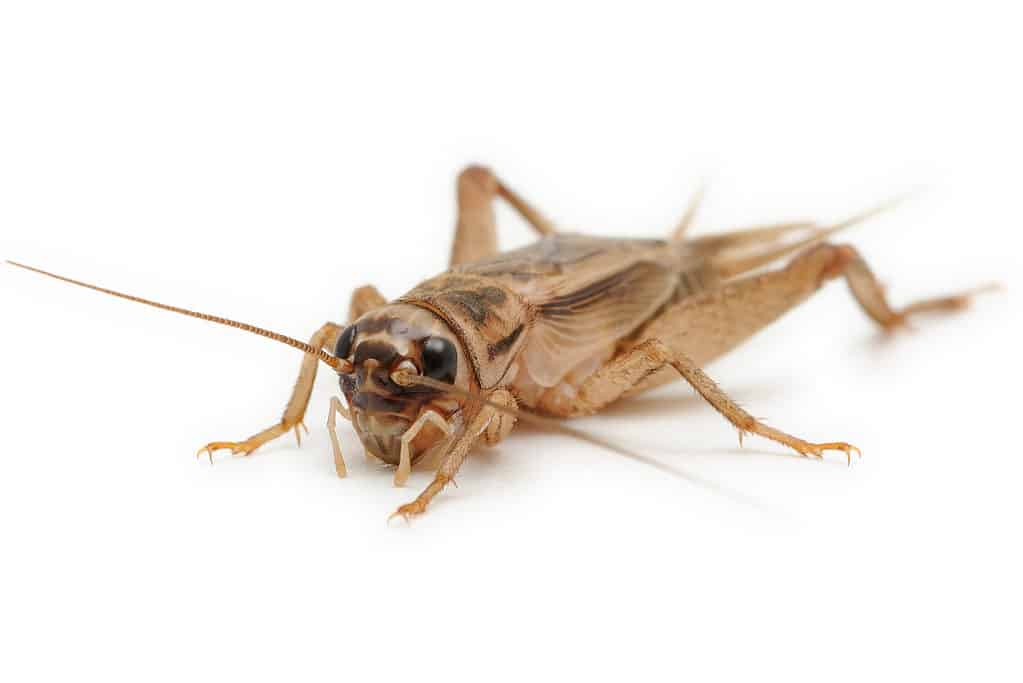Beginner reptile enthusiasts who want an interesting pet with a striking appearance and a docile nature should consider adopting an African fat-tailed gecko. Often mistaken for the leopard gecko, the African fat-tailed gecko is a bit smaller with a trademark “fat” tail.
Learn more about this incredible lizard, including the supplies needed, the food they eat, and the care they’ll need.

The African Fat-Tailed Gecko
Originally from West Africa, the African fat-tailed gecko stands out among other reptile pets for a few reasons:
- They’re very small.
- They’re nocturnal.
- They don’t need much training.
- They drop their tails if frightened.
At just over seven inches long, this gecko’s most striking characteristic is its accordion-like tail that can grow to over an inch wide. Furthermore, the recent popularity of the African fat-tailed gecko has prompted breeders to create different color patterns and morphs through each clutch they produce. Now, more colors are widely available from which pet owners can choose.

African fat-tailed geckos have an abnormally long tail, which is where they get their name.
©Kaan Sezer/iStock via Getty Images
While a bit skittish, young geckos of this species will learn to tolerate — and even enjoy — handling by humans if trained in it from a young age. This docileness, combined with their low-maintenance care and interesting appearance, make the African fat-tailed gecko one of the most popular non-allergenic pets in the world.
Purchase Cost

Depending on the morph, a rare African fat-tailed gecko could cost over $500 dollars.
©Kaan Sezer/iStock via Getty Images
Your local pet shop probably won’t have an African fat-tailed gecko for sale, but that doesn’t mean you won’t be able to find one! Breeders across the world ship these lizards nationally and internationally to ensure every reptile lover has the chance to care for and love this fascinating creature.
You can buy an African fat-tailed gecko for as low as $25 at some online retailers, though many of those sales are only as supplies last. The average cost of an African fat-tailed gecko ranges between $125 and $550. Most of the price depends on age and morph color. Some of the most expensive morphs on the market now are:
- Whiteout morph.
- Tangerine-Caramel morph.
- Zulu morph.
- Striped Oreo morph.
Additionally, age will change the cost of the gecko. Babies are cheaper than adults, as adults can be bred and cost less to maintain. Babies cannot reproduce and take more time and resources to grow during their first six months of life.
Supplies

These geckos don’t need more than light, a heat source, a cage, and some substrate. If you’d like to add a branch or other dynamic part to their environment, they would appreciate it.
©Kaan Sezer/iStock via Getty Images
As a pet, the African fat-tailed gecko doesn’t need much in terms of supplies. Outside of their habitat and food, you won’t need to buy a ton of accessories (like you would for a dog, cat, or bird). To keep your gecko safe and happy, you’ll want to buy:
- A reptile terrarium.
- Light and heat sources.
- Substrate.
The terrarium you choose is up to you; however, only use a terrarium if you have one gecko. If you’ve decided to adopt two or more, make sure you get a 10-gallon aquarium. As a rule, avoid housing two male geckos together — they will get territorial and pose injury risks to each other.
African fat-tailed geckos evolved to get away from the sun and humidity. However, light and heat are vital to their survival. As such, owners should have a heating pad and light to simulate these environments. Experts believe that heating is best done from below, so attempt to get an under-the-tank heating pad that remains at approximately 90 degrees Fahrenheit. However, this heating pad should not cover the entire bottom of the cage; only a portion, so your gecko can thermoregulate their body by moving from the warmer side to the cooler side as they need.
These geckos do not need UVB light because they’re nocturnal. They will, however, need about 10 to 12 hours of light a day.
Substrate for African fat-tailed geckos is one of the only other things you’ll need to fill their cage with. Branded items like Repticarpet make a great choice that’s both easy to clean and unable to be digested. Another lower-cost option is paper towels, newspaper, or butcher paper. While sand might be your first thought, use caution — many geckos have used this and gotten very sick. If ingested, sand can impact their gut and cause serious injury or death.
Finally, adding one or two “safe” places to crawl into and sleep gives your gecko a peaceful retreat away from light and other distractions happening in the larger space. You can make this complex or simple — like a plastic container turned over with a hole cut out for an entrance. Keep at least one corner of the cage moist, as well, to aid in your gecko’s periodic shedding.
Food

When feeding your gecko live crickets, make sure they’re properly sized for the size of your gecko.
©iStock.com/Florian DENIS
These geckos subsist on a diet of live insects; particularly crickets and mealworms. While silkworms, waxworms, and pinkie mice are acceptable, they shouldn’t be staples in the diet of your gecko. Instead, give these as fatty additives once or twice every few weeks.
If you’ve bought a baby gecko, you’ll want to feed them about four or five crickets a day. For adults, the amount of food changes considerably: about nine crickets every three days. Adults can substitute mealworms for cricket if their palate enjoys them more. While you can leave mealworms in the enclosure in a dish, you should remove crickets after a few hours if your gecko does not eat them.
For both babies and adults, dust the crickets or mealworms with a calcium powder that ensures the most important nutrients are getting into your gecko’s system.
Finally, make sure your gecko consistently has clean, fresh drinking water.
Care and Maintenance

When well taken care of, African fat-tailed geckos can live longer than some dogs and cats.
©Ameng Wu/iStock via Getty Images
African fat-tailed geckos are hardy and live long lives. In captivity, if taken care of well, these lizards can live up to almost 20 years.
These geckos are self-sufficient and don’t need much in terms of enrichment, amusement, or commonly-defined “affection” from their humans. Instead, they’ll want a clean living space, enough food to keep them satisfied, and a few treat insects every now and then.
When adopting an African fat-tailed gecko, ensure you have a local veterinarian who understands reptile physiology. While these geckos don’t often suffer from illnesses, they are susceptible to metabolic bone disease, retained shed, and malnutrition. A vet with experience in reptiles can help you diagnose and solve these (and other) common gecko health problems.
The only other thing to know: take it easy for the first few weeks around your gecko so they can get used to your presence and their new surroundings. They will drop their tail when they’re scared or frightened. It will regenerate, but it will look different than before.
Other than the periodic vet visit, ongoing food and substrate costs, and lightbulbs or a new heating pad, your African fat-tailed gecko won’t bust the bank.
Spot Your New Best Friend: The African Fat-Tailed Gecko
With an easygoing nature, a nocturnal schedule, and an easy diet, the African fat-tailed gecko is a great pet choice for amateur reptile owners. They’re small, which makes them a good choice for older kids, and tend not to bite. If you choose an African fat-tailed gecko as a pet, make sure they get plenty of nutrition and have the proper habitat to live a long, healthy life.
The photo featured at the top of this post is © GlobalP/iStock via Getty Images
Thank you for reading! Have some feedback for us? Contact the AZ Animals editorial team.







